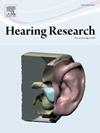Promotion of a new gap junction gene Cx46 (GJA3) expression in the cochlea after Cx26 (GJB2) deficiency
IF 2.5
2区 医学
Q1 AUDIOLOGY & SPEECH-LANGUAGE PATHOLOGY
引用次数: 0
Abstract
Gap junction GJB2 (connexin 26, Cx26) gene mutations are responsible for >50 % of nonsyndromic hearing loss. The pathological changes mainly locate in the cochlea. However, little is known about genetic changes in the cochlea after Cx26 deficiency. In this study, we employed bulk Poly(A) RNA-Seq technique and found that Cx26 deficiency could cause many genes up- and down-regulated in the cochlea. One of the unexpected findings is significant upregulation of a gap junctional gene GJA3 (Cx46), which normally expresses in the eye rather than the ear. Quantitative PCR and digital droplet PCR further confirmed the promotion of Cx46 expression in the cochlea after Cx26 deficiency. Immunofluorescent staining showed that the promoted Cx46 was expressed at the same location as Cx26 expression in the cochlea and integrated into the same gap junctional plaques. This promotion is Cx26-specific; there was no promotion of Cx46 expression in the cochlea after knockout (KO) of Cx30 (GJB6), which is another predominant connexin co-expressed in the cochlea. Gene Set Enrichment Analysis (GSEA) revealed that Cx26 deficiency but not Cx30 KO upregulated a phototransduction pathway to promote the eye-specific gene Cx46 expression in the cochlea. This may present a natural compensation to the loss of Cx26 function, since both Cx26 and Cx46 have similar channel properties. Our findings also provide a new cue for developing a genetic approach to treat this common hereditary deafness.
Cx26 (GJB2)缺乏后耳蜗新间隙连接基因Cx46 (GJA3)表达的促进
间隙连接GJB2(连接蛋白26,Cx26)基因突变导致50%的非综合征性听力损失。病理改变主要发生在耳蜗。然而,对Cx26缺乏后耳蜗的遗传变化知之甚少。在本研究中,我们采用了bulk Poly(A) RNA-Seq技术,发现Cx26缺乏会导致耳蜗中许多基因的上调和下调。其中一个意想不到的发现是间隙连接基因GJA3 (Cx46)的显著上调,该基因通常在眼睛而不是耳朵中表达。定量PCR和数字液滴PCR进一步证实了Cx26缺乏后耳蜗中Cx46表达的促进作用。免疫荧光染色显示,促进的Cx46与Cx26在耳蜗中的表达位置相同,并整合到相同的间隙连接斑块中。这个促销是cx26特有的;Cx30 (GJB6)是耳蜗中另一种主要的共表达连接蛋白,敲除(KO) Cx30 (GJB6)后,耳蜗中Cx46的表达未得到促进。基因集富集分析(GSEA)显示,Cx26缺乏而非Cx30 KO上调了一条光导通路,促进了耳蜗中眼睛特异性基因Cx46的表达。这可能是对Cx26功能损失的自然补偿,因为Cx26和Cx46都具有相似的通道属性。我们的发现也为开发一种治疗这种常见遗传性耳聋的遗传方法提供了新的线索。
本文章由计算机程序翻译,如有差异,请以英文原文为准。
求助全文
约1分钟内获得全文
求助全文
来源期刊

Hearing Research
医学-耳鼻喉科学
CiteScore
5.30
自引率
14.30%
发文量
163
审稿时长
75 days
期刊介绍:
The aim of the journal is to provide a forum for papers concerned with basic peripheral and central auditory mechanisms. Emphasis is on experimental and clinical studies, but theoretical and methodological papers will also be considered. The journal publishes original research papers, review and mini- review articles, rapid communications, method/protocol and perspective articles.
Papers submitted should deal with auditory anatomy, physiology, psychophysics, imaging, modeling and behavioural studies in animals and humans, as well as hearing aids and cochlear implants. Papers dealing with the vestibular system are also considered for publication. Papers on comparative aspects of hearing and on effects of drugs and environmental contaminants on hearing function will also be considered. Clinical papers will be accepted when they contribute to the understanding of normal and pathological hearing functions.
 求助内容:
求助内容: 应助结果提醒方式:
应助结果提醒方式:


